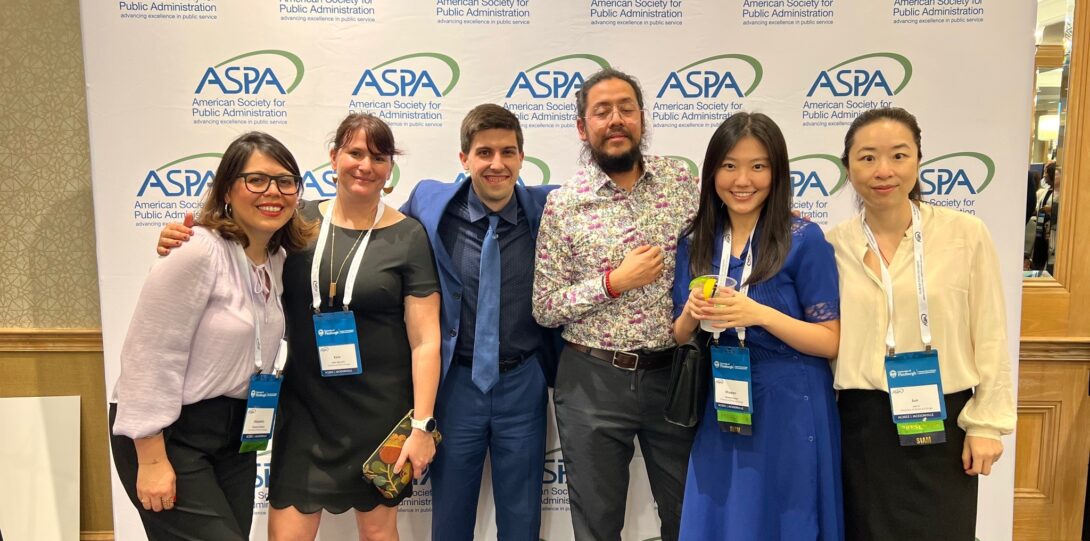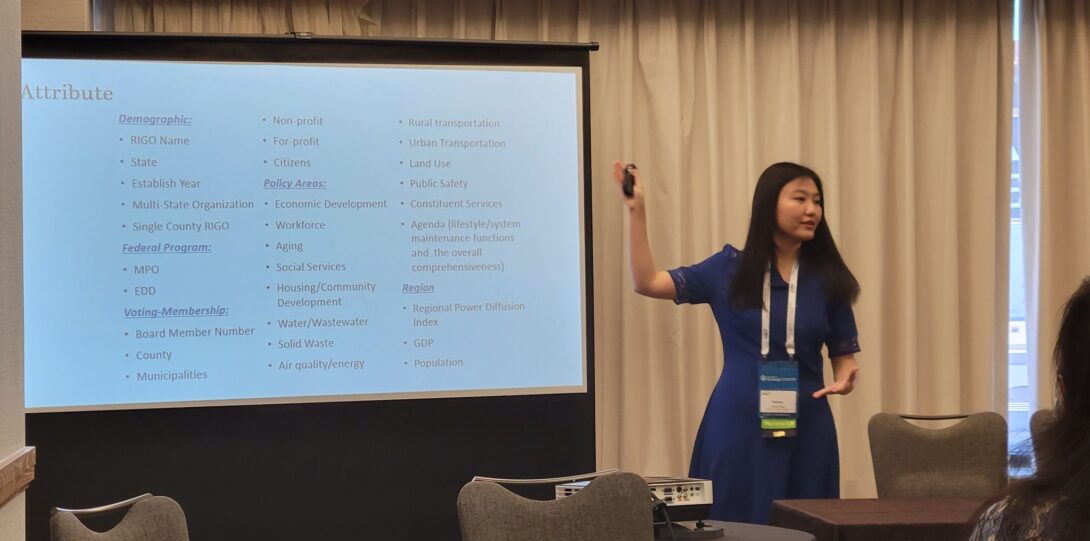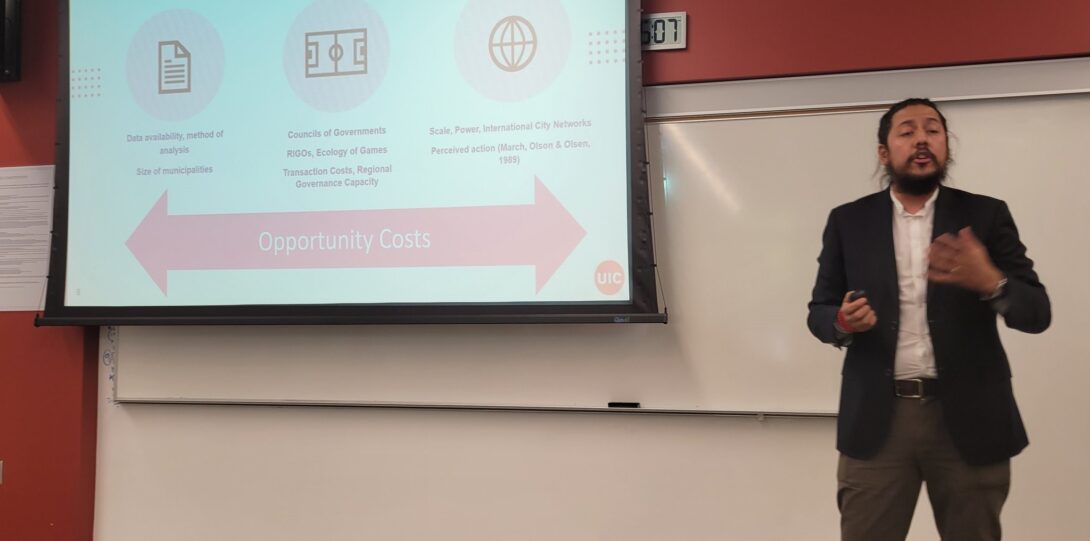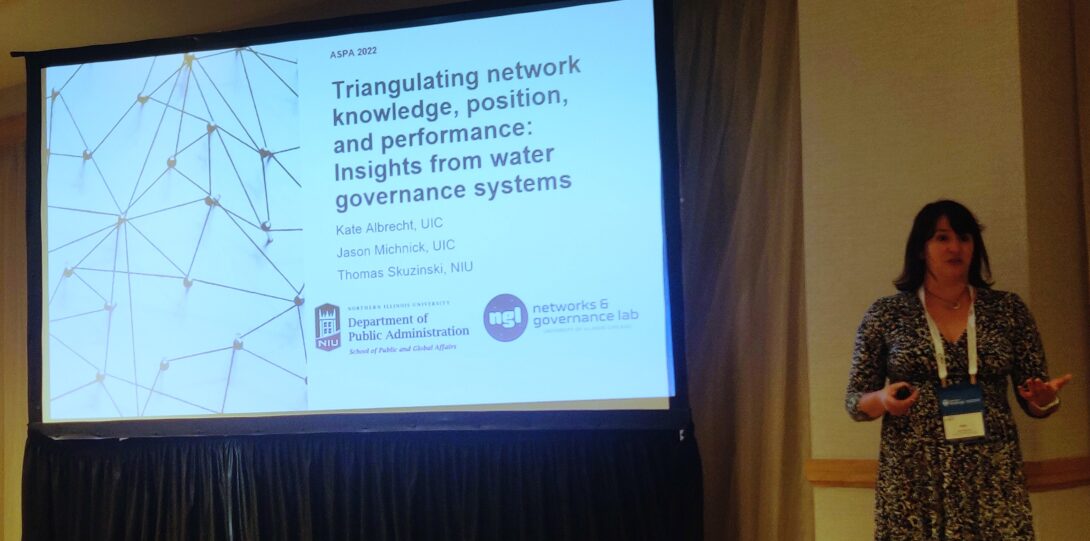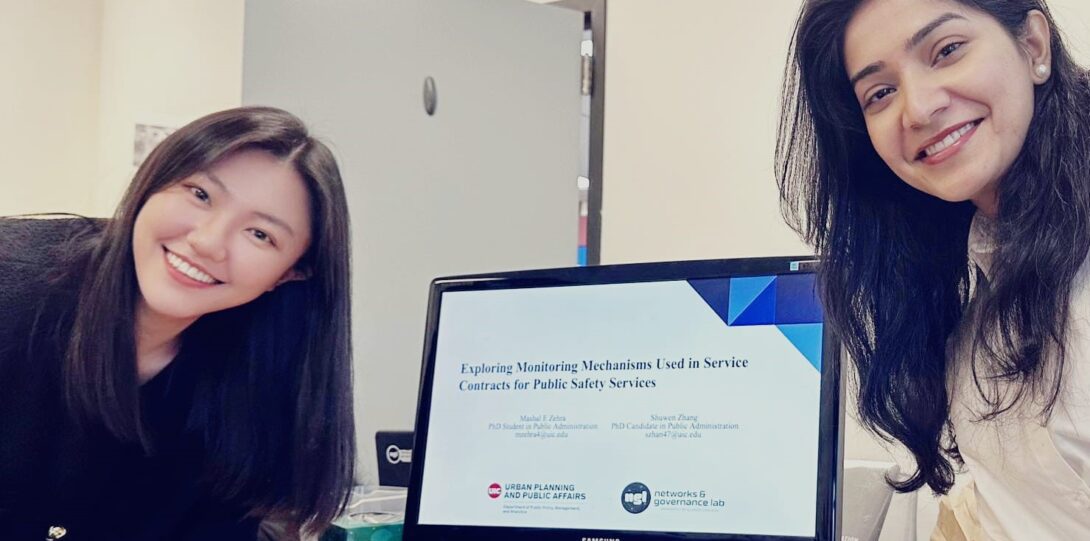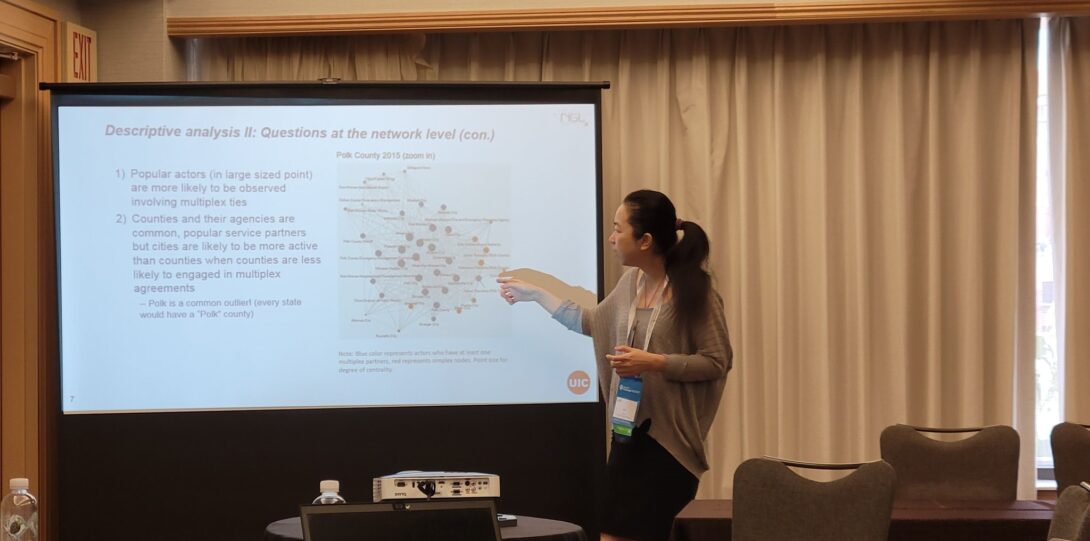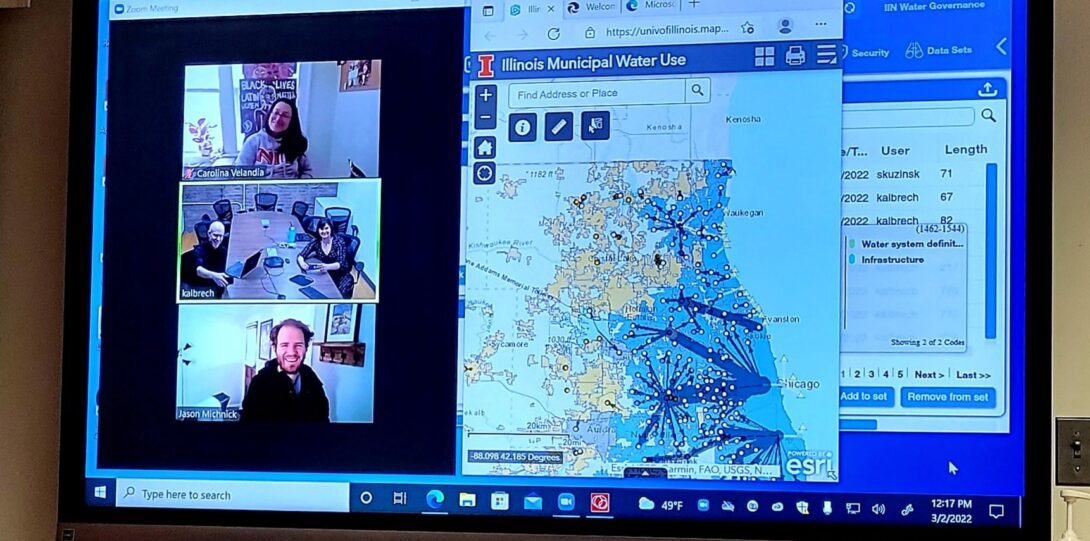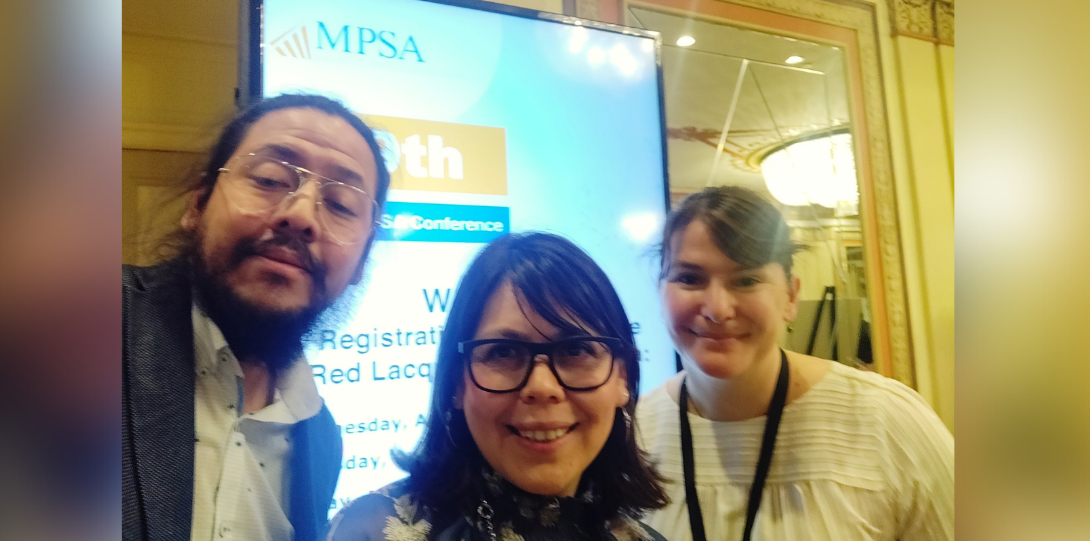NGL Presentations
Welcome to the Research Presentations page for our Network Governance Lab at the University of Illinois Chicago. Here, you will find a collection of past presentations delivered by our researchers at various conferences and events.
We invite you to explore our collection of presentations, which include abstracts, slides, and videos of our talks. By sharing our insights and perspectives, we hope to contribute to a better understanding of network governance and inspire new ideas and collaborations in this exciting field.
NGL Presentations
Exploring Monitoring Mechanisms Used in Service Contracts for Public Safety Services
Exploring Monitoring Mechanisms Used in Service Contracts for Public Safety Services
Mashal E Zehra and Shuwen Zhang
Advancing Theory and Practice of Intergovernmental Collaboration through Analyses of Iowa’s Archive of 28E Agreements
Advancing Theory and Practice of Intergovernmental Collaboration through Analyses of Iowa’s Archive of 28E Agreements
Presented at the 2023 Deil Wright Symposium
Jered B. Carr
Rain or Shine: How Large-Scale Disasters Affect the Evolution of Emergency Management Networks Across Time. A Quasi-Experimental Design
Rain or Shine: How Large-Scale Disasters Affect the Evolution of Emergency Management Networks Across Time. A Quasi-Experimental Design
Authors: Alejandra Medina and Michael Siciliano
PMRC 2021 Video Presentation
PMRC Presentation Slides
A Longitudinal Analysis of Fiscal Stress and Local Government Collaboration
A Longitudinal Analysis of Fiscal Stress and Local Government Collaboration
Authors: Jose Sanchez, Jun Li, Aamer Shaheen Ranjha, and Michael Siciliano
PMRC 2021 Video Presentation
Assessing the Risk Hypothesis: How Do Production Characteristics, Partners, and Political Interest Shape Network Structure?
Assessing the Risk Hypothesis: How Do Production Characteristics, Partners, and Political Interest Shape Network Structure?
Authors: Michael Siciliano, Jered Carr, and Sam Kurtz
PMRC 2021 Video Presentation
PMRC Presentation Slides
Assessing the Risk Hypothesis: How Do Production Characteristics, Partners, and Political Interest Shape Network Structure?
Assessing the Risk Hypothesis: How Do Production Characteristics, Partners, and Political Interest Shape Network Structure?
Authors: Michael Siciliano, Jered Carr, and Sam Kurtz
PMRC 2021 Video Presentation
PMRC Presentation Slides
Institutions of a Kind: Determinants of Monitoring Mechanisms for Nonprofit Service Delivery
Institutions of a Kind: Determinants of Monitoring Mechanisms for Nonprofit Service Delivery
Authors: Sam Kurtz, Saman Shafiq, and Kate Albrecht
Local Governments and Shared Services: Insights on Institutional Mechanisms, Partners, and Purpose
Local Governments and Shared Services: Insights on Institutional Mechanisms, Partners, and Purpose
Authors: Jun Li, Jose Sanchez, Michael Siciliano, and Jered Carr
Toward a Unified Approach to Studying the Role of Nonprofits in Public Service Delivery
Toward a Unified Approach to Studying the Role of Nonprofits in Public Service Delivery
2020 ARNOVA TIBS (Theories, Issues, and Boundaries) Best Paper Award
Authors: Saman Shafiq, Kate Albrecht, and Kelly LeRoux
Towards a Map of Monitoring Mechanisms: The Role of Institutions and Activities in Monitoring Cross-Sector Service Delivery
Towards a Map of Monitoring Mechanisms: The Role of Institutions and Activities in Monitoring Cross-Sector Service Delivery
Authors: Sam Kurtz, Saman Shafiq, and Kate Albrecht
Role of the Non-profit Sector among Regional Inter-governmental Organizations (RIGOs): A Mixed-method Study
Role of the Non-profit Sector among Regional Inter-governmental Organizations (RIGOs): A Mixed-method Study
Omowonuola Fayemiro & Shuwen Zhang
Multiplexity in Public Safety: Motivations and Strategic Course
Multiplexity in Public Safety: Motivations and Strategic Course
Jun Li
Does the Decision-Making Structure Matter to the Policy Function Setting of Regional Intergovernmental Organizations?
Does the Decision-Making Structure Matter to the Policy Function Setting of Regional Intergovernmental Organizations?
Shuwen Zhang
The Next Frontier: Inter-Institutional Dynamics in Regional Problem Solving
The Next Frontier: Inter-Institutional Dynamics in Regional Problem Solving
Samuel Kurtz
Interacting Network Complexity: A Network of Networks Analysis on Public Safety Service System
Interacting Network Complexity: A Network of Networks Analysis on Public Safety Service System
Jun Li
ASPA 2023
2023 Deil Wright Symposium Panel
Panel Overview
Panel Overview
Moderator
Jered B. Carr
This panel is organized around the “28E” dataset developed by the Networks & Governance Lab (NGL) at the University of Illinois Chicago. Each of the papers on this panel utilizes this unique dataset to advance our understanding of how local governments use formal collaborations with one or more other governments, nonprofit, and for-profit organizations to deliver services and coordinate policy actions. Research using these data fills an important gap in a literature that is largely dependent on data drawn from cases involving a few service/policy areas, single time periods, and limited geographic areas. These studies capture partial networks at best, often at a single point in time, and typically reduce the content of ties to reports of interactions, frequent contacts, and some other vague term indicating collaboration.
NGL’s dataset contains intergovernmental agreements created by Iowa’s governments under the authority of Chapter 28E. State law permits “state and local governments in Iowa to make efficient use of their powers by enabling them to provide joint services and facilities with other agencies and to cooperate in other ways of mutual advantage” (Chapter 28E, Section 1). The statute requires the resulting intergovernmental and intersector agreements be filed with the Secretary of State before they can be entered into force, and the state government has created a public archive containing these agreements that is continuously updated as new agreements, renewals, and termination notices are uploaded by local governments. Importantly, the 28E archive includes the full text of each agreement, providing detailed information about the scope of activities involved and the obligations of each party under the agreement.
Over the last five years, the NGL has utilized this public archive to build a dataset that provides detailed information for approximately 20,000 agreements created by state agencies and local governments across Iowa between 1993 and 2018. The metadata captured for each agreement include the names and organizational types of the parties and the activity category selected by the person submitting the agreement to the archive. Submitters can choose from 33 different categories, including Criminal Investigation, Economic Development, Education, Emergency Management, Fire Response, Information Services, Jail and Corrections, Police Protection, Street and Road Systems, and Water Systems. Researchers in the lab have developed a protocol for coding more than a dozen additional variables drawn from the text of the agreements, including duration, payment structure and frequency, forms of mandated reporting, rules for party disputes, extent of operational integration and shared governance, and creation of a principal-agent relationship.
Researchers at NGL have used these data to describe the agreements and resulting networks created by local governments in Iowa, and to test theories about collaborative public management, network formation and evolution, and related questions of public policy and regional governance. To date, researchers affiliated with NGL have used these data in more than two dozen conference papers, ten articles and book chapters, and five dissertations. The four papers included in this panel provide a sample of the range of these data to examine important questions, including how it can be used to describe the monitoring mechanisms principals include in agreements with agents, identify layers of highly correlated networks created for multidimensional services, and examine the impact of specific factors, whether jurisdictional resources, age, and demographics or the policy declarations made by higher levels of government, have on the adoption of agreements over time.
Paper 1: Exploring Monitoring Mechanisms in Interlocal Collaborations on Public Safety
Paper 1: Exploring Monitoring Mechanisms in Interlocal Collaborations on Public Safety
Mashal-E-Zehra and Shuwen Zhang
By choosing interlocal service agreements as the integration mechanisms to deal with collective action problems, local governments may commit to institutional arrangements that structure power differently between the service provider (the agent) and the delegator (the principal). The existence of power asymmetries between governments and non-government actors in the principal-agent relations, that may hamper or facilitate coordination and monitoring of interlocal cooperation, has been widely acknowledged in literature (Long, 1949; Hickson et al, 1971; Carr, Gerber, and Lupher, 2007; Whitford, 2009). While extant research has focused on explaining and offering solutions to collective action dilemmas and principal-agent problems (Dixit et al.,1997; Gailmard, 2009; Khalil et al, 2007), there is limited evidence of how governments structure incentives and monitor compliance through contract and agency designs across power differentials between autonomous governments and non-government partners. With the exception of a few studies (Thurmaier, 2005; Chen and Thurmaier, 2009; Hugg, 2020; Li et al., 2021), attention on decisions about contractually specified monitoring mechanisms in local government contracts is lacking.
This paper explores the monitoring mechanisms local governments use to monitor partners across principle-agent dynamics. We use a random sample of service contract agreements drawn from a unique dataset on 28E agreements developed by The Networks & Governance Lab (NGL) at the University of Illinois Chicago. Our study goes beyond existing literature by distinguishing between various types of monitoring mechanisms used by local governments to structure principal-agent relationships. We identify three types of monitoring mechanisms: financial, information-sharing, and evaluation-based. The preliminary findings show that the use of these monitoring clauses varies across principal-agent dynamics and service areas.
Paper 2: Interacting Network Complexity: A Networks of Networks Analysis of Collaboration on Public Safety Services
Paper 2: Interacting Network Complexity: A Networks of Networks Analysis of Collaboration on Public Safety Services
Jun Li
Local public services are often ecologies of different activities that interact and evolve together, forming a complex network cosmos in which different categories of service activities can be viewed as different layers of networks. However, the literature on public service networks typically focuses on connectivity links within a narrow set of similar activities rather than among the multiple activities that constitute the whole network system of the public service examined. In this paper, I use the networks of networks perspective to examine the varying venues and patterns of interdependencies of different layers of public safety service networks created by governments in Iowa and the path toward integrative governance over 24 years.
This paper addresses two explorative questions. First, whether are interactions between some service networks more likely to occur than in other pairs of public safety service networks? Second, what are the implications of the evolutionary path for regional safety governance? Quadratic Assignment Procedure (QAP), through correlation and logit regressions, is employed to identify the variations of interacting venues among five categories of public safety service activities: police protection, criminal investigation, emergency management, fire response, and jails and corrections. The findings show clustering among groups of nodes in the police protection, emergency management, and fire response networks. The clustering is consistent in the latter two layers of networks and after 2010. The findings suggest factors such as changes in resources and the imposition of state mandates may influence participants’ choice of partners.
Paper 3: Who are you going to call? How Large-Scale Disasters Affect the Evolution of Networks Across Time. A Quasi-Experimental Design
Paper 3: Who are you going to call? How Large-Scale Disasters Affect the Evolution of Networks Across Time. A Quasi-Experimental Design
Alejandra Medina
Despite the importance of network forms of organization to address complex policy challenges, little is known about the evolution of collaborative relationships over time. The lack of longitudinal network data has been identified as a significant limitation in furthering our understanding of how collaborative governance processes unfold and change across time (Berardo, 2020; Siciliano et al., 2021; Ulibarri et al., 2020). The assessment of collaboration networks at more than one point in time can facilitate the identification of variables that affect tie formation. This research contributes to the collaborative governance and network tie formation research by analyzing the development of emergency management collaboration networks in Iowa. Chapter 28E of the Iowa Code requires local authorities to file all instances of interlocal agreements with the Secretary of State’s office before entering into force. Using metadata from the agreements I identify all emergency management agreements and develop complete networks among the actors for each year. Combined with administrative data on city and county demographics and finances, I model the evolution of the emergency management networks using stochastic actor-oriented models (SAOMs). The model examines how actor attributes, like size and location, and structural factors, such as transitivity and centralization, influence the network’s evolution from year to year. This study also uses a quasi-experimental approach to examine how disaster declarations for a certain city or county in a given year shape tendencies to form or dissolve ties. Overall, this research will contribute to i) the analysis of the conditions that lead to the formation of ties in emergency management networks, ii) a better understanding of the evolution of collaborative governance processes across time, and iii) the identification of elements that could be useful to public managers for the management of large-scale disaster events.
Paper 4: With a Little Help from my Friends: Central Cities in Service Delivery Networks
Paper 4: With a Little Help from my Friends: Central Cities in Service Delivery Networks
José Sánchez
The literature on collaboration for public services delivery has devoted great attention to the institutional dynamics of cities contracting out services and jointly producing or providing services with other local governments, nonprofit or private organizations. Questions related to the factors that increase the likelihood for said collaborative dynamics and the nature of the cooperative ties that local units create are fundamental to our understanding of these networks and their performance. Notwithstanding, there are still some questions related to the actors of nodes that could potentially collaborate that can be explored more thoroughly.
Empirical research on this line has discussed whether fiscal stress or political ideology affect the probability of a city collaborating with a neighboring partner. Similarly, other characteristics of local governments could be driving or deterring their likelihood for collaboration. This study explores whether central cities are less likely to collaborate with other local governments in four service domains using a unique statewide dataset of interlocal agreements in a ten-year period. Traditional regression analyses have dropped central cities because their distinctive characteristics turned them into outliers that break assumptions of normal distribution. This study relies on longitudinal network models that test whether the characteristics of central cities relative to their neighboring local governments -older incorporation as cities, high fiscal stress, large population, and demographic diversity- make them less likely to engage in collaborative arrangements for service delivery. Results indicate that municipalities who are closer to each other and local governments categorized as “older cities” due to their incorporation year are more likely to collaborate.
